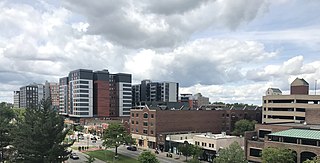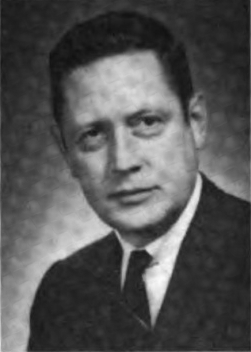Related Research Articles

Lansing is the capital of the U.S. state of Michigan. It is mostly in Ingham County, although portions of the city extend west into Eaton County and north into Clinton County. The 2020 census placed the city's population at 112,644, making it the sixth largest city in Michigan. The population of its metropolitan statistical area (MSA) was 541,297 at the 2020 census, the third largest in the state after metropolitan Detroit and Grand Rapids. It was named the new state capital of Michigan in 1847, ten years after Michigan became a state.

East Lansing is a city in the U.S. state of Michigan. Most of the city lies within Ingham County with a smaller portion extending north into Clinton County. At the 2020 Census the population was 47,741. Located directly east of the state capital of Lansing, East Lansing is well-known as the home of Michigan State University. The city is part of the Lansing–East Lansing metropolitan area.

The Michigan Supreme Court is the highest court in the U.S. state of Michigan. It is Michigan's court of last resort and consists of seven justices. The Court is located in the Michigan Hall of Justice at 925 Ottawa Street in Lansing, the state capital.

The Constitution of the State of Michigan is the governing document of the U.S. state of Michigan. It describes the structure and function of the state's government.

Thomas McIntyre Cooley was the 25th Justice and a Chief Justice of the Michigan Supreme Court, between 1864 and 1885. Born in Attica, New York, he was father to Charles Cooley, a distinguished American sociologist. He was a charter member and first chairman of the Interstate Commerce Commission (1887).

Central Michigan, also called Mid Michigan, is a region in the Lower Peninsula of the U.S. state of Michigan. As its name implies, it is the middle area of the Lower Peninsula. Lower Michigan is said to resemble a mitten, and Mid Michigan corresponds roughly to the palm, encompassing the fertile rolling plains of the Michigan Basin. The region contains cities of moderate size, including Flint, Saginaw, and the state capital of Lansing.

Thomas E. Brennan was an American attorney, jurist, and academic administrator who was the founder of Thomas M. Cooley Law School and the 81st Justice and chief justice of the Michigan Supreme Court.

Railroads have been vital in the history of the population and trade of rough and finished goods in the state of Michigan. While some coastal settlements had previously existed, the population, commercial, and industrial growth of the state further bloomed with the establishment of the railroad.
The Detroit, Lansing and Northern Railroad (DL&N) is a defunct railroad which was formed on December 27, 1876 as a reorganization of the foreclosed Detroit, Lansing and Lake Michigan Rail Road. The segment of its main line from Detroit to Lansing became an important component of the Pere Marquette Railroad, organized in 1900, and is still in use by CSX.
The Patterson Railroad is a defunct railroad that existed in Michigan during the early 1870s. The company incorporated on September 21, 1870 and filed articles on October 3 to construct a line between Patterson Mills and Kiddville. The Patterson completed a 1.67-mile (2.69 km) in July 1872, at which point the property became part of the Detroit, Lansing and Lake Michigan Railroad, whose line it met at Kiddville. The DL&M would later become part of the Pere Marquette Railroad, which also built a line south from Belding.
The Ionia and Lansing Rail Road is a defunct railroad which operated in the state of Michigan in the 1860s and 1870s. The company incorporated on November 13, 1865; the investors hailed primarily from Lansing, Ionia and Portland. The original charter called for a 34-mile (55 km) line from Ionia to Lansing; on January 13, 1869 this was amended with a much grander vision: a 125-mile (201 km) line from Lansing to the mouth of the Pentwater River at Pentwater, on the shores of Lake Michigan.
The Detroit, Howell and Lansing Railroad is a defunct railroad which operated in central and southeast Michigan during the early 1870s. The company formed on March 29, 1870 through the consolidation of the Detroit and Howell and the Howell and Lansing. From the two companies the DH&L gained a partially graded right-of-way 84 miles (135 km) long, with track laid on perhaps half of it, stretching from Lansing southeast to Detroit.
The Detroit and Howell Railroad (D&H) is a defunct railroad organized in 1864 to build a line connecting Howell and Detroit in southeast Michigan.
The Howell and Lansing Railroad is a defunct railroad which proposed to construct a railway line between Howell and Lansing in central Michigan. The company incorporated on June 23, 1868 and began grading along the 33-mile (53 km) length of the line. The H&L had some difficulty obtaining financing; by the time it merged with the Detroit and Howell on March 29, 1870, no track had been laid. The two companies merged formed the Detroit, Howell and Lansing, and the H&L ceased to exist as an independent company.
Michigan United Railways (MUR) was an interurban which owned and leased numerous lines in the state of Michigan during the early twentieth century.

The St. Joseph Valley Rail Road is a defunct railroad which operated in southern Michigan during the mid-19th century.
WALLY was a commuter rail service proposed in 2008 which would have linked the Michigan cities of Ann Arbor and Howell. It never got past the planning stages.

Michigan has a republican form of government with three branches of government: the executive branch consisting of the governor of Michigan and the other independently elected constitutional officers; the legislative branch consisting of the House of Representatives and Senate; and the judicial branch consisting of the one court of justice. The state also allows direct participation of the electorate by initiative, referendum, recall, and ratification.

The following outline provides an overview of and topical guide to the U.S. state of Michigan:
References
- Crittenden, A. Riley (1911). A History of the Township and Village of Howell, Michigan. Howell, Michigan: Livingston tidings print.
- Dunbar, Willis F. (1969). All Aboard! A History of Railroads in Michigan. Grand Rapids, Michigan: William B. Eerdmans. OCLC 54650.
- Meints, Graydon M. (1992). Michigan Railroads and Railroad Companies. East Lansing, Michigan: Michigan State University Press. ISBN 978-0-87013-318-3.
- Michigan Legislature (1870). Joint Documents of the State of Michigan for the year 1870. Lansing.
{{cite book}}: CS1 maint: ref duplicates default (link) - Michigan Supreme Court (1870). "The People ex rel the Detroit and Howell R.R. Co. v. the Township Board of Salem". American Law Register . IX: 487–507.
{{cite journal}}: CS1 maint: ref duplicates default (link)